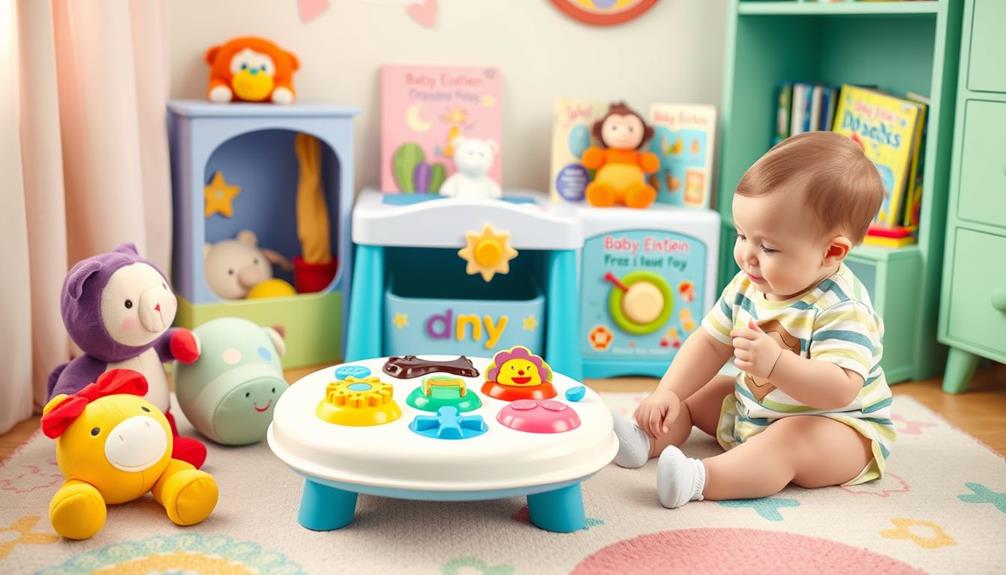Beetroot is a fantastic superfood for baby-led weaning, packed with essential nutrients. Try making beetroot pancakes, sweet potato sticks, or colorful smoothie bowls that appeal to your baby's senses. Fritters and hummus are fun finger foods, while roasted wedges are easy for little hands to grasp. For a tasty puree, blend cooked beets with apples, or whip up a vibrant pesto pasta. Each recipe is not only nutritious but encourages self-feeding too. Exciting and healthy, these unique dishes will make mealtimes enjoyable. Keep exploring to discover even more delicious ways to incorporate beetroot into your baby's diet!
Key Takeaways
- Beetroot pancakes made with blended beets and oats provide a soft texture, perfect for babies starting to self-feed.
- Beetroot and sweet potato sticks can be steamed or roasted, offering a nutritious finger food option for little hands.
- Beetroot fritters combine mashed beets and oats, creating a crispy texture that encourages self-feeding for toddlers.
- Beetroot hummus serves as a smooth dip, promoting exploration of flavors and textures for baby-led weaning.
- Colorful beetroot smoothie bowls blend beets with yogurt and fruits, engaging babies visually while delivering essential nutrients.
Beetroot Pancakes for Babies
Beetroot pancakes are a delightful and nutritious choice for your little one as they commence on their weaning journey. Packed with essential vitamins and minerals, these pancakes are low in calories (just 28 kcal each), making them a perfect fit for healthy eating. Incorporating ingredients that support holistic lifestyle approaches can further enhance your baby's nutrition.
To prepare, simply blend soft beets with ripe bananas, oats, and a pinch of cinnamon for added flavor. Cooking the pancakes on low heat guarantees they remain soft and easy for babies to chew. This reduces the risk of choking, which is vital during baby-led weaning.
You can serve these colorful pancakes warm, topped with mashed berries or yogurt, promoting a delicious and nutritious meal without added sugars. One of the best things about beetroot pancakes is their convenience. If you make a batch and have leftovers, you can store them in an airtight container in the fridge for 2-3 days or freeze them for up to 3 months.
This makes them a convenient meal option for busy parents looking to provide healthy choices for their little ones. Try these beetroot pancakes and watch your baby enjoy a tasty and nutritious start to their solid food journey!
Beetroot and Sweet Potato Sticks
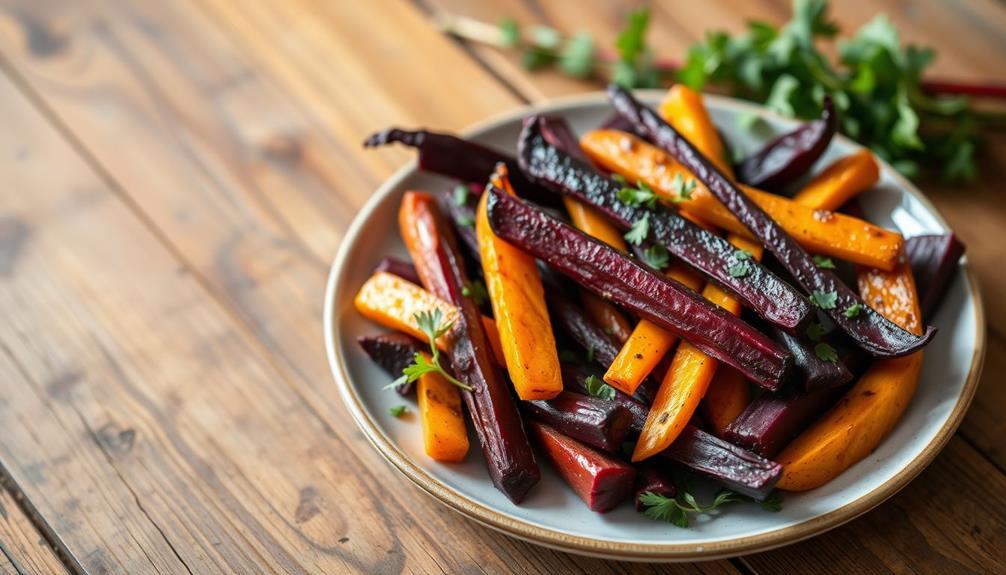
Introducing beetroot and sweet potato sticks to your baby's diet is a fun and nutritious way to explore new flavors and textures.
These vibrant sticks are perfect for baby-led weaning, offering an appealing finger food option that your little one will enjoy. Plus, they pack a punch with essential nutrients! Incorporating such colorful vegetables can inspire a love for healthy eating early on, aligning with the principles of a healthy lifestyle that will benefit your child in the long run.
Here are some benefits and preparation tips:
- Nutritional Powerhouse: Beetroot and sweet potatoes are rich in vitamins A, C, fiber, and antioxidants, supporting your baby's immune system and digestive health.
- Safe Texture: Steaming or roasting the sticks until tender guarantees a soft texture, minimizing choking hazards for your baby.
- Flavor Balance: The natural sweetness of sweet potatoes balances the earthy taste of beets, creating a delightful flavor combination that will intrigue your baby's palate.
- Serving Ideas: Serve the sticks plain or with a healthy dip, like beetroot pesto, to encourage exploration of different flavors and textures.
Beetroot Fritters for Little Hands

Often, little hands love exploring new textures and flavors, and beetroot fritters are a fantastic way to engage their curiosity. These colorful and nutritious finger foods are perfect for babies 6 months and older, promoting self-feeding and allowing them to grasp and enjoy each bite.
To enhance their health benefits, consider incorporating a balanced diet rich in essential nutrients, as this can support healthy growth and development in young children nutritional support during illness.
To make beetroot fritters, simply combine cooked and mashed beets with oats, eggs, and any optional seasonings you prefer. Then, pan-fry the mixture until golden for a crispy texture that toddlers will find delightful.
The vibrant color of these fritters not only grabs your baby's attention but also encourages them to explore new tastes at mealtime.
One of the best things about beetroot fritters is their versatility; you can serve them warm or cold, making them a convenient snack option for busy parents on the go.
Plus, they're rich in essential nutrients like fiber, folate, and antioxidants, which support healthy growth and development in young children.
With beetroot fritters, you're offering your little one a fun and nutritious way to enjoy their food while mastering the art of self-feeding.
Beetroot and Banana Smoothie
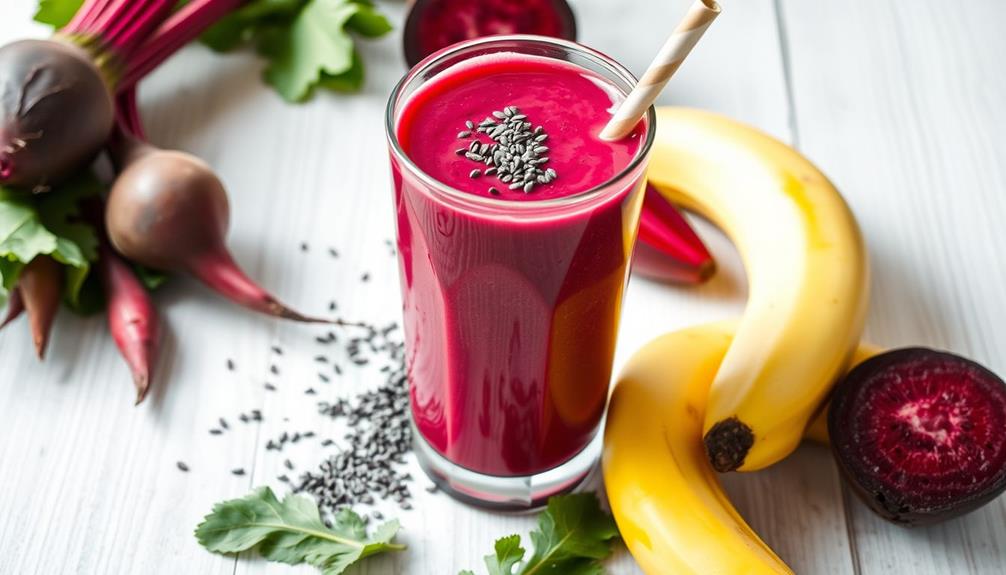
A delicious and nutritious option for your little one is the Beetroot and Banana Smoothie, which perfectly balances the earthy flavor of beets with the sweetness of ripe bananas. This vibrant smoothie not only looks appealing, but it's also packed with nutrients that can support your baby's growth, making it a great addition to their diet as they explore new flavors.
Additionally, beets are known for their health benefits such as improving blood flow and providing essential vitamins.
To prepare this delightful banana smoothie, follow these steps:
- Use one small roasted beet for a smooth beet puree.
- Add one ripe banana for natural sweetness and extra nutrients.
- Blend with a splash of water or breast milk/formula to achieve the desired consistency.
- Adjust the texture as needed for your baby's preference.
This smoothie offers high fiber content, potassium, and vitamins A and C from the beets, along with vitamin B6 from the banana.
The combination of earthy flavor and creamy texture makes it an excellent choice for babies starting solids. Plus, the bright color is sure to engage your little one visually, encouraging them to explore new flavors and textures through baby-led weaning.
Enjoy this healthy treat and watch your baby savor every sip!
Beetroot Hummus for Dipping
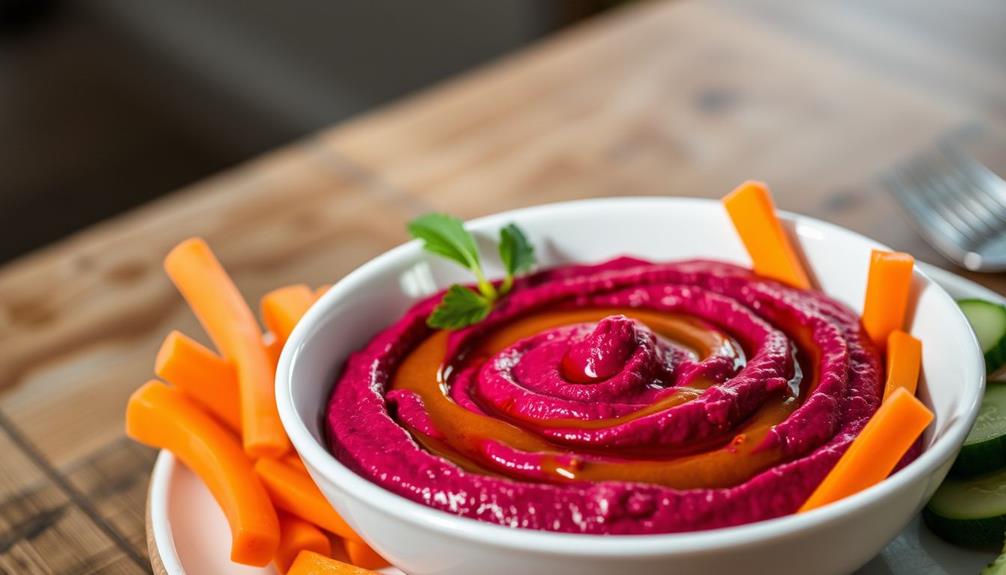
Beetroot Hummus for Dipping is another fantastic way to incorporate the vibrant and nutritious beet into your baby's diet. This nutrient-rich dip combines cooked beets, tahini, garlic, lemon juice, and olive oil, making it an excellent choice for baby-led weaning.
The bright color and smooth texture of beetroot hummus will entice your little one to explore new flavors while providing essential vitamins and minerals such as folate, iron, and vitamin C. Engaging in self-feeding with this dip can also enhance your baby's coordination and fine motor skills, contributing to their overall importance and benefits of play during mealtime.
When preparing beetroot hummus for babies, make sure to blend all the ingredients until smooth. This helps create a creamy consistency that's easy for them to eat, reducing any choking hazards.
You can serve this delicious dip with soft finger foods like steamed vegetables, whole grain pita, or breadsticks. This encourages self-feeding and helps develop fine motor skills.
Plus, beetroot hummus can be stored in an airtight container in the refrigerator for up to five days, offering you a convenient and healthy snack option for busy days.
Your baby will love the exciting flavors, and you'll appreciate the nutritious benefits of this delightful dip!
Beetroot and Quinoa Balls
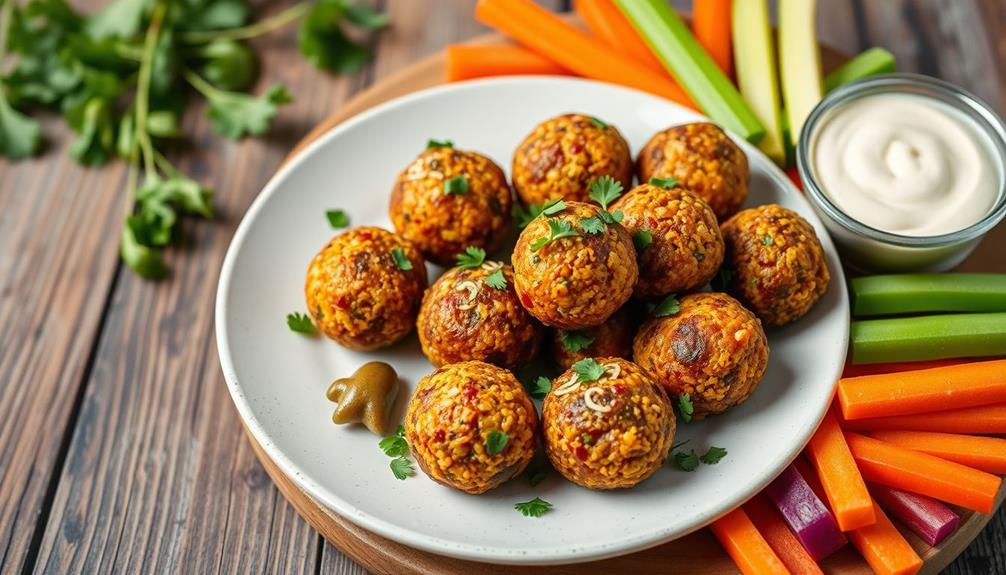
Beetroot and quinoa balls pack a nutritional punch, offering protein and fiber that support your baby's growth.
These vibrant ingredients can also be appealing to your little one's taste buds, as they're rich in natural sweetness and essential vitamins.
You'll love experimenting with flavor pairings that enhance the natural sweetness of beetroot, making meals more exciting.
Plus, knowing how to cook and store these bites can make mealtime easier for you and your little one.
For additional tips on cat health and nutrition, it's always beneficial to consult a veterinarian when considering new foods.
Nutritional Benefits of Quinoa
Quinoa offers numerous nutritional benefits that make it an ideal ingredient for baby-led weaning, especially in dishes like beetroot and quinoa balls. This versatile grain is packed with crucial nutrients that can support your baby's growth and development.
Here are four key benefits of quinoa:
- Complete Protein: Quinoa contains all nine essential amino acids, making it a fantastic protein source to meet your baby's nutritional needs.
- Rich in Fiber: The high fiber content aids digestion and promotes healthy bowel movements, guaranteeing your little one stays comfortable.
- Vitamins and Minerals: Quinoa is loaded with important vitamins and minerals, such as magnesium, iron, and B vitamins, contributing to overall health and vitality.
- Gluten-Free: Being naturally gluten-free, quinoa is a safe choice for babies with gluten sensitivities or celiac disease.
With its low glycemic index, quinoa also helps maintain stable blood sugar levels, providing sustained energy for your active toddler.
Incorporating quinoa into your baby's diet through delicious recipes like beetroot and quinoa balls guarantees they get a nutritious boost while exploring new flavors and textures.
Flavor Pairings With Beetroot
Combining beetroot with quinoa creates a vibrant and nutritious dish that's perfect for baby-led weaning. These beetroot and quinoa balls offer a delightful flavor combination, where the earthiness of beetroot beautifully complements the nutty flavor of quinoa. This results in a moist, well-bound ball that's easy for little hands to grasp.
The nutritional benefits of this pairing are impressive. Beetroot enhances the dish with vitamins A, C, and fiber, while quinoa stands out as a complete protein source, providing all nine essential amino acids. This makes the balls not only visually appealing but also a healthy choice for your baby.
To prepare these delightful bites, simply cook the quinoa and steam or roast the beetroot. Once they're blended together, shape the mixture into small balls and either bake or pan-fry them.
These beetroot and quinoa balls are suitable for babies aged 9 months and older, encouraging self-feeding and supporting the development of fine motor skills. With this flavorful dish, you're setting the stage for a positive baby-led weaning experience that your little one will love!
Cooking and Storage Tips
When you're ready to whip up those delicious beetroot and quinoa balls, it's essential to focus on the cooking method and texture. First, you'll want to roast or steam the beets until they're tender. Once cooked, combine them with the quinoa, breadcrumbs, and your choice of seasonings. Confirm the mixture is moist enough to hold together but not overly wet, as that can affect the final texture.
Here are some cooking and storage tips for your beetroot and quinoa balls:
- Cook: Bake the shaped balls until they're golden brown for a crispy exterior.
- Storage: Keep cooked balls in an airtight container in the fridge for up to 3 days, or freeze them for up to 3 months for convenient meal prep.
- Reheating: Thaw frozen balls overnight in the fridge, then bake at 350°F (175°C) for about 15-20 minutes to reheat.
- Serving Suggestions: Pair your beetroot balls with a healthy dip like beetroot pesto to enhance flavor and boost health benefits for your little one. Enjoy!
Roasted Beetroot Wedges
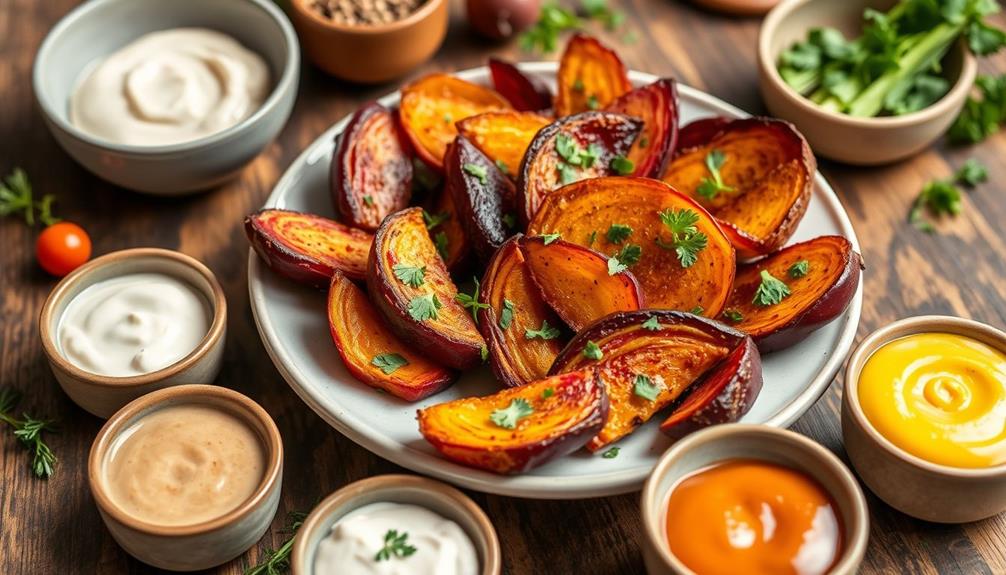
Roasted beetroot wedges aren't just delicious; they pack a nutritional punch that's great for your little one.
These healthy bites are also rich in vitamins and minerals, making them an excellent choice for growing babies.
You'll appreciate the simple cooking techniques that make these wedges soft and safe for self-feeding.
Plus, with some creative serving suggestions, you can make mealtime both fun and healthy for your baby.
For more ideas on keeping your pet healthy while you focus on baby-led weaning, check out dog health tips.
Nutritional Benefits of Beets
The nutritional power of roasted beetroot wedges makes them an ideal food choice for babies starting on their weaning journey. Packed with essential nutrients, beets offer a range of benefits that support your little one's growth and development.
Here are some key nutritional benefits of beets:
- Vitamins and Minerals: Roasted beetroot wedges are rich in folate, iron, and vitamin C, which are essential for your baby's overall health.
- Digestive Health: The fiber in beets promotes healthy digestion, helping to prevent constipation and ensuring regular bowel movements.
- Antioxidants: Beets contain betalains, powerful antioxidants that reduce inflammation and protect against oxidative stress, boosting your baby's immune system.
- Low-Calorie Option: With only about 24 calories per serving, beets provide a nutrient-dense food option without excessive energy intake.
Cooking Techniques Overview
Preparing roasted beetroot wedges is a straightforward and rewarding process that introduces your baby to the delicious flavors of beets. Start by washing and peeling the beets, then cut them into evenly sized wedges. This guarantees uniform cooking, which is essential for successful weaning.
Next, toss the wedges in olive oil and season with a pinch of salt. Preheat your oven to 400°F (200°C) and roast the beetroot for about 25-30 minutes, flipping halfway through. Your goal is to achieve tender, slightly caramelized wedges that can be easily mashed with a fork, reducing choking hazards for baby-led weaning.
Confirm you allow the roasted wedges to cool before serving. Cut them into smaller, manageable pieces that your infant can grip and self-feed. Here's a quick overview of the process:
| Step | Action | Purpose |
|---|---|---|
| Wash and peel | Clean beets and remove skin | Prepare for cutting |
| Cut into wedges | Uniform pieces for even cooking | Confirm proper texture |
| Toss in olive oil | Enhance flavor and texture | Make them more appealing |
| Roast | Cook until tender and caramelized | Ideal for baby-led weaning |
Serving Suggestions for Babies
When serving roasted beetroot wedges to your little one, cut them into long, thin strips for easier grasping and chewing. This not only promotes self-feeding skills but also guarantees the roasted beetroot is soft enough for your baby to mash with their gums.
Here are some tasty serving suggestions to make mealtime fun and nutritious:
- Pair with olive oil: Lightly drizzle the wedges with olive oil for added flavor and healthy fats essential for your baby's development.
- Colorful combinations: Serve the roasted beetroot alongside other soft finger foods, like cooked sweet potatoes or avocado, to create a visually appealing plate.
- Experiment with herbs: Sprinkle a little cinnamon or thyme on the roasted wedges to introduce your baby to new flavors and aromas.
- Dipping fun: Offer a small bowl of yogurt or hummus for dipping, making mealtime interactive while introducing new tastes.
These serving suggestions not only enhance the flavor of the roasted beetroot but also encourage your baby's exploration of textures and flavors, making mealtime an enjoyable experience!
Beetroot and Apple Puree
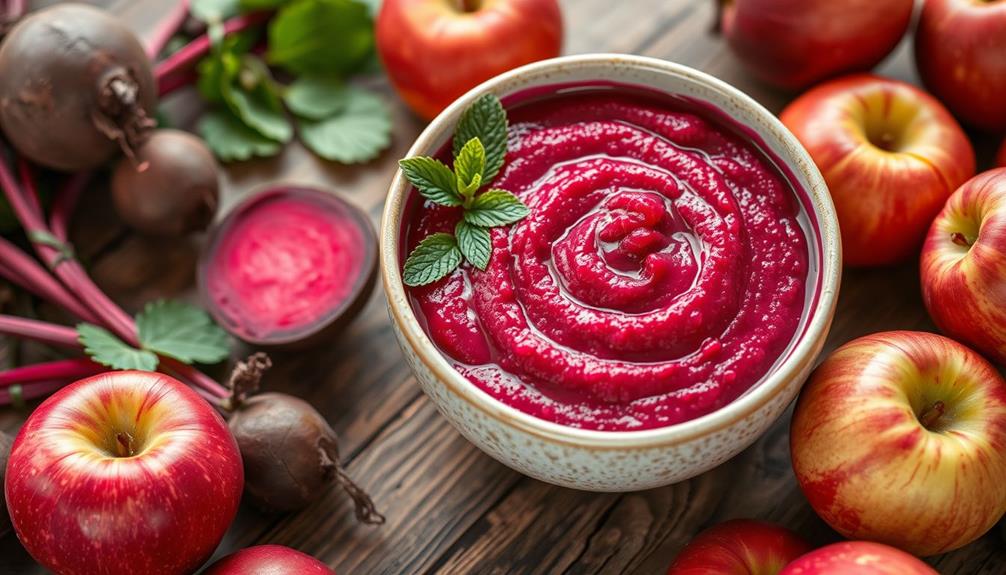
Beetroot and Apple Puree offers a delightful blend of earthy and sweet flavors, making it a nutritious choice for your little one starting at 6 months. This puree combines the vibrant taste of cooked beets with the natural sweetness of apples, providing essential vitamins A and C that support your baby's immune function and growth.
Additionally, the natural properties of beets may help promote overall health, similar to how certain essential oils can enhance well-being through therapeutic benefits.
To prepare this simple puree, steam peeled and chopped beets until they're tender, which takes about 15-20 minutes. You can blend them with either cooked or raw apples to make a smooth puree that's perfect for younger babies.
The vibrant color of this mixture not only appeals to your baby's visual senses but also encourages them to explore new flavors and textures during mealtime.
If you have any leftovers, store them in an airtight container in the refrigerator for up to 3 days. Alternatively, freeze the puree in ice cube trays for convenient portions that can last up to 6 months, ensuring you always have nutritious options on hand.
This beetroot and apple puree is a fantastic way to introduce healthy eating habits to your little one!
Beetroot Pesto Pasta
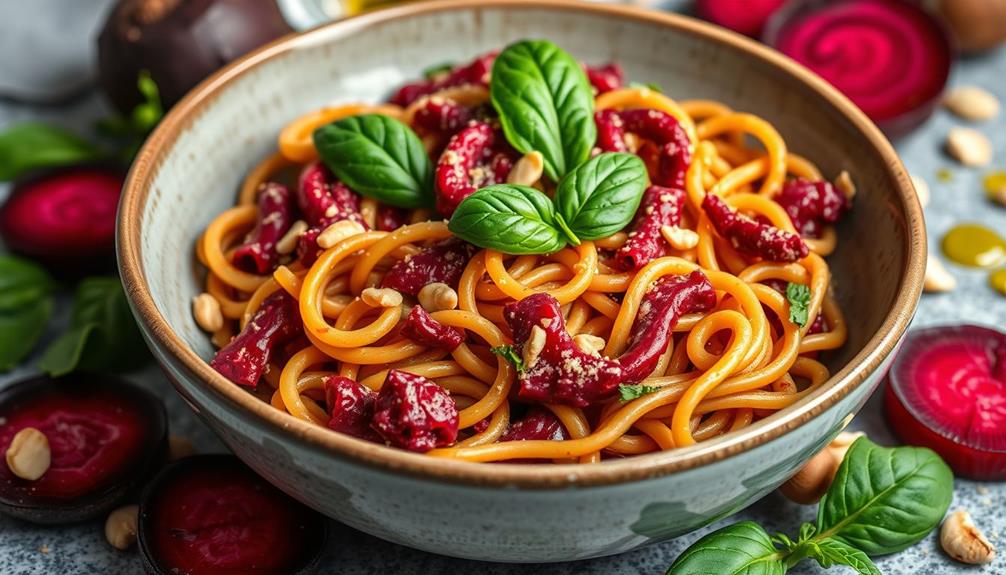
Have you considered adding a splash of color and nutrition to your baby's meals? Beetroot pesto pasta is a fantastic way to do just that! This dish combines the earthy flavor of beets with the nutty richness of nuts and cheese, making it an ideal option for baby-led weaning.
Not only does this dish introduce vibrant flavors to your baby's palate, but it also encourages creativity in meal preparation, aligning with the importance of fostering a creative environment at home.
Here's how to whip it up:
- Blend cooked beets with basil, garlic, nuts (like pine nuts or walnuts), and a splash of olive oil until smooth.
- Toss the vibrant beetroot pesto with cooked pasta for a delicious meal.
- Serve it up, ensuring the soft texture minimizes choking hazards while encouraging self-feeding.
- Store any leftovers in an airtight container in the fridge for up to 5 days or freeze in ice cube trays for easy meal prep later.
This colorful dish is packed with vitamins and minerals, including folate and iron, which are essential for your baby's growth and development.
Beetroot pesto pasta not only looks appealing but also promotes healthy eating habits from an early age. So why not give it a try? Your little one will love it!
Colorful Beetroot Smoothie Bowl
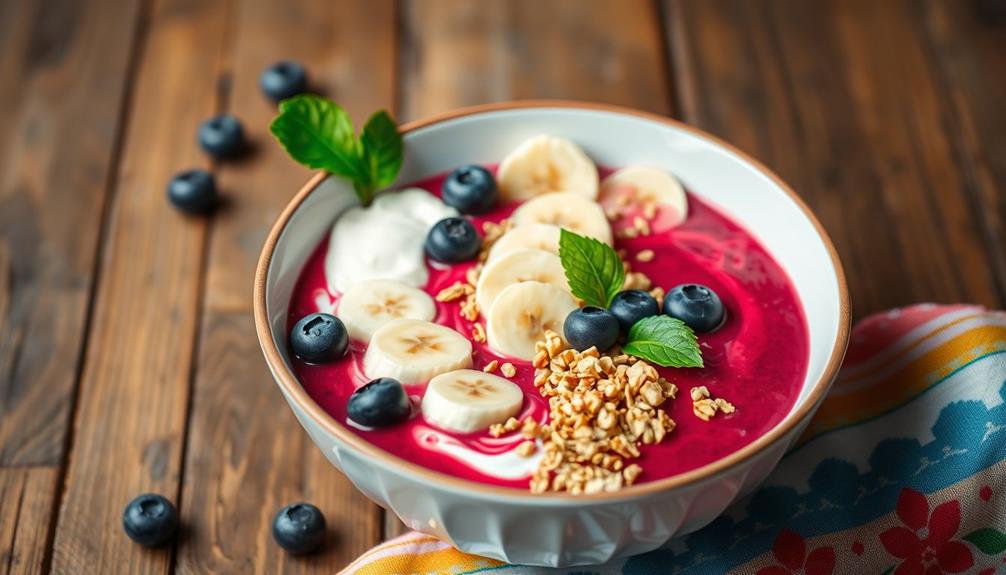
Looking for a fun and nutritious way to start your baby's day? A colorful beetroot smoothie bowl is just what you need! Blend cooked or raw beets with yogurt, banana, and a splash of milk to create a vibrant, nutrient-rich breakfast or snack option for babies over 6 months.
Beetroots not only offer a beautiful color but also possess essential nutrients that can enhance overall allure and health, similar to how certain zodiac signs may be perceived as more appealing socially certain signs are viewed as more appealing. The natural sweetness of the beets, combined with the creaminess of yogurt and fruity banana, results in a deliciously smooth texture that your little one will love.
To make it even more appealing, serve the smoothie bowl topped with sliced strawberries, blueberries, or a sprinkle of granola. This not only makes it visually enticing but also encourages self-feeding skills in your babies.
Beetroots are packed with essential nutrients like folate, vitamin C, and fiber, promoting healthy growth and digestion.
If you want to enhance the flavor, consider adding a pinch of cinnamon or a tablespoon of nut butter, but remember to introduce allergens gradually. This colorful beetroot smoothie bowl is a delightful way to guarantee your baby gets the nutrients they need while enjoying a tasty meal!
Frequently Asked Questions
How Do You Serve Beets for Baby Led Weaning?
When you're serving beets for baby-led weaning, start by cooking them until they're soft enough for your baby to mash or gum easily.
Cut the beets into strips or wedges, making them easy for little hands to grasp. You can also pair them with flavors like apple or sweet potato for variety.
Consider offering beet slices as finger foods or blending them into smoothies for a nutritious, easy-to-consume option.
Can I Give Beetroot to a 6 Month Old Baby?
Imagine your friend Sarah, who enthusiastically introduced her 6-month-old baby to beets.
Yes, you can give beetroot to a 6-month-old, as long as they're showing signs of readiness.
Just make sure to cook the beets until they're soft enough to mash easily.
It's always wise to check with your healthcare provider first, especially if there are allergy concerns.
Beetroot's fiber and nutrients can support your baby's healthy growth and development.
How Do I Cook Beetroot for My 7 Month Old?
To cook beetroot for your 7-month-old, you can steam, roast, or boil it.
Steam the beets for 15-20 minutes until soft enough to mash.
For roasting, peel and cut them into small pieces, toss with olive oil, and bake at 195°C (380°F) for 30-40 minutes.
If you prefer boiling, cook whole, unpeeled beets for 20-30 minutes, then peel.
Always cut them into strips or wedges for easy handling by your baby.
What Is the Difference Between Beetroot and Baby Beetroot?
Beetroot and baby beetroot differ mainly in size and taste.
You'll find mature beetroot larger and with a deeper flavor, while baby beetroot is smaller, sweeter, and more tender.
When cooking, baby beetroot requires less time due to its softer texture, making it easier to prepare.
Nutritionally, both are rich in vitamins, but baby beetroot has a higher water content, which makes it less calorie-dense.
This difference can influence your meal choices.
Conclusion
Who knew that this vibrant veggie could transform mealtime into a colorful adventure? As you plunge into these beetroot recipes, you might just find that your little one's new favorite food is a root vegetable that stains everything in sight. But isn't it ironic? You're trying to create a mess-free weaning experience, only to discover that beetroot brings a splash of chaos—and joy—to the table. Embrace the mess, because those little hands are learning and exploring, one beetroot bite at a time!




